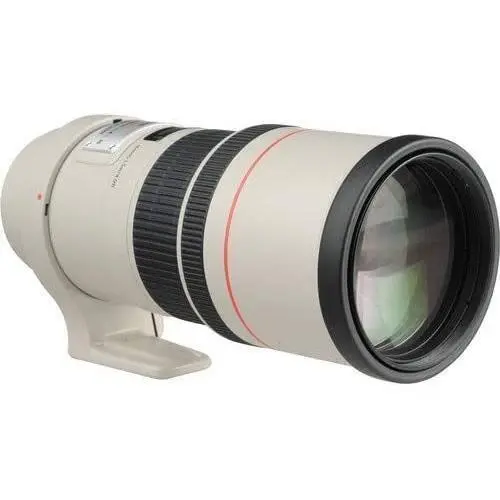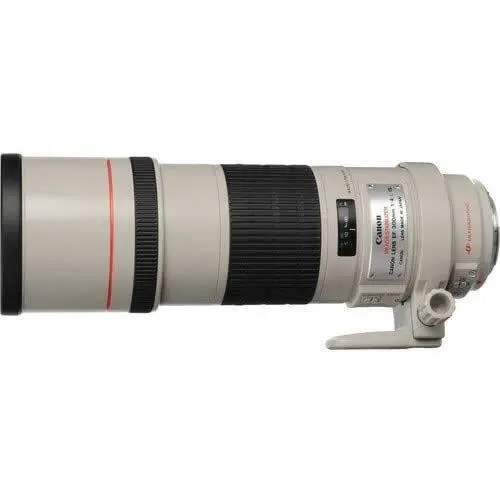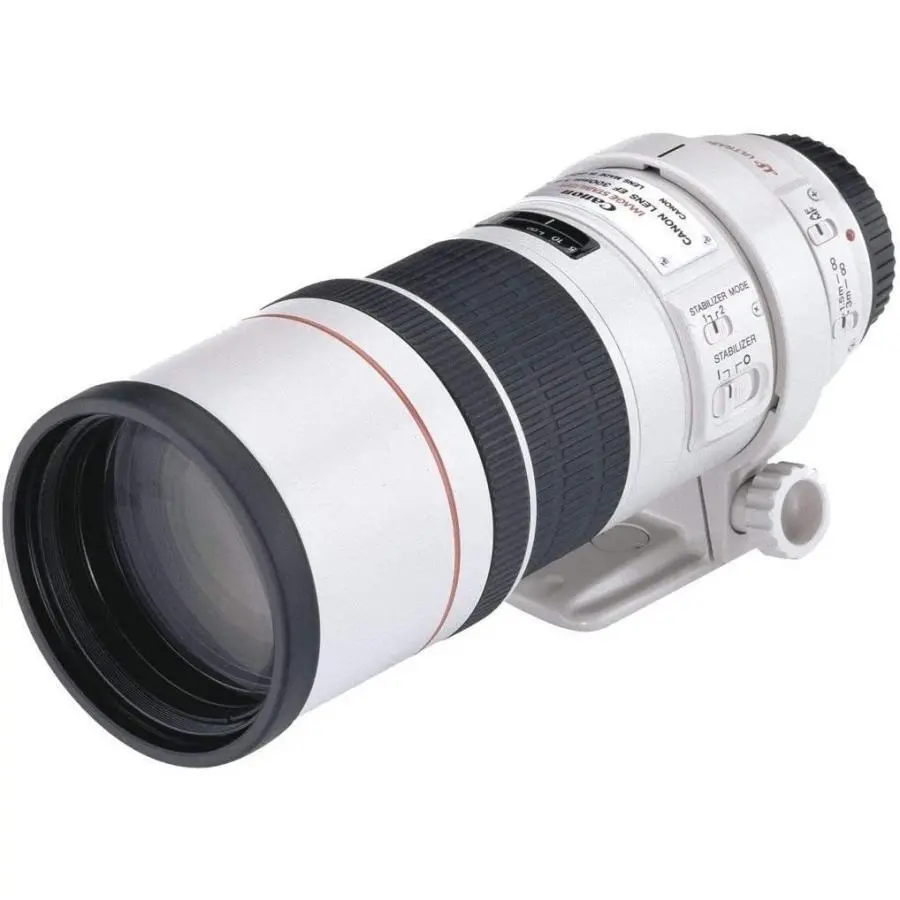Canon EF 300mm f/4 L IS (Full-frame, 1.3x and and APS-C coverage, 77mm filters, 41.6 oz./1,180g lens only, 45.8 oz./1,298g with collar, 4.9’/1.5m close focus, about $1,350 after rebate).
Introduction
This Canon 300mm f/4 is high performance, fast and lightweight telephoto lens for every Canon DSLR and 35mm EOS camera. It has great optics, fast autofocus and top-notch build quality.
While most people prefer a 70-300 or 100-400mm zoom, other people prefer this fixed 300mm f/4 to Canon’s 70-300 zooms for it’s higher speed (better for action shots) and better optical quality. It’s preferred over Canon’s 100-400mm zooms for its lighter weight, lower price and higher speed.
Just grab the focus ring at any time for instant manual-focus override.
The tripod collar slides off the back, but leaves several metal nubbins poking out.
This professional L lens is a bargain today because it’s been in Canon’s catalog so long. Canon has long since paid for its development cost, so it sells for much less than similar but newer lenses. The only gotcha is that this is one of Canon’s first Image Stabilization lenses, and thus IS doesn’t work to speeds as slow as do newer lenses.
It’s much lighter than 70-200/2.8 or 100-400mm zooms, and much sharper than a 70-200mm with a teleconverter.
Name
Canon calls this the CANON LENS IMAGE STABILIZER EF 300mm f/4 L IS.
IMAGE STABILIZER and IS mean that you don’t need a tripod.
EF means “electronic focus;” there is an autofocus motor inside the lens.
L means as expensive as L.
Optics

Canon EF 300mm f/4L IS internal diagram. UD Glass.
15 elements in 11 groups.
Multicoated.
Internal focussing.
Focal Length
300mm.
When used on an APS-C camera, it sees an angle of view similar to what a 485mm lens sees when used on an FX or 35mm camera.
Angle of View, full frame
8.2º diagonal.
4.5º vertical.
6.8º horizontal.
Diaphragm
Canon 300mm f/4L IS at f/4. (EF diaphragm not visible).
8 straight blades.
Stops down to f/32.
Close Focus
4.9 feet (1.5m) from the image plane.
Maximum Reproduction Ratio
1:4.2 (0.24x).
Image Stabilizer
Rated two stops improvement.
Hard Infinity Focus Stop?
No.
Focus Scale
Yes.
Depth-of-Field Scale
No.
Infra-Red Focus Index
No.
Filters
77mm.
Size
Canon specifies 3.5″ (90 mm) diameter by 8.7″ (221 mm) long.
Weight
45.770 oz. (1,297.5g), actual measured, with collar.
41.617 oz. (1,179.9g), lens alone without collar.
4.150 oz. (117.7g), collar alone.
Canon specifies 42.0 oz. (1,190g).
Hood
Built-in telescoping hood.
Hood locks in extended position with screw threads, bravo!
Canon EF 300mm f/4 L IS with hood extended.
Caps
New 77mm Canon pinch-type front cap and standard EOS rear cap.
Tripod Collar
The tripod collar comes off from the back.
It’s called the Tripod Mount Ring B (W). The 180/3.5 Macro uses the same ring, in black: Tripod Mount Ring B (B).
Case
Canon includes a very nice padded nylon LZ1128 case.
This is a very useful sturdy padded case. You can use the double-handled zipper for solid closing, and once open, there’s velcro on the top for shot-to-shot open and closing. Bravo!
Introduced
March 1997.
Canon Model Number
2530A004.
Included
Lens.
Tripod collar.
Caps.
LZ1128 case.
Price, USA
2014 December: $1,350 after rebate.
Performance
The Canon 300mm f/4 L is sharp and easy to use.
Auto/Manual Switching
Just grab the ring anytime for instant manual-focus override.
AF Speed
AF is fast; not instantaneous, but fast.
It’s a little faster than the original 300mm f/2.8 L.
AF Accuracy
AF is always dead-on.
Recommendations
This lens is for photographers who demand the highest optical quality, and are willing to forego the convenience of a zoom to get it. It also weighs much less than the 70-200/2.8 and 100-400mm zooms.
Photographically, a 300/4 throws backgrounds much further out of focus than a 70-200 does at 200mm. This is why the 300/4 makes a great portrait and headshot lens. It lets us stand farther away for better facial rendering (perspective), and at f/4 blows-out any annoying background into a wall of soft color far better than any 200mm lens can at f/2.8.
If money and weight are no object, I prefer the new 100-400mm IS II, but if you don’t need a zoom and don’t need great Image Stabilization — or if you prefer its faster aperture, lower cost or lighter weight — then get this 300/4 IS.







